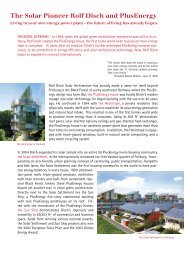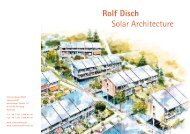Heliotrope - Rolf Disch
Heliotrope - Rolf Disch
Heliotrope - Rolf Disch
You also want an ePaper? Increase the reach of your titles
YUMPU automatically turns print PDFs into web optimized ePapers that Google loves.
<strong>Rolf</strong> <strong>Disch</strong> SolarArchitektur – Merzhauser Str. 177 - 79100 Freiburg - Tel 0761 459 44-0 Fax 0761<br />
459 44-44<br />
batteries use heavy metals which have to be disposed in a proper way. Further network supply<br />
guarantees higher system efficiency.<br />
Some investigations show that a supply amount to the public network of 20% by renewable energy<br />
sources for electric power generation is possible without problems. An amount which is actually far<br />
away to be reached.<br />
The yearly power output of the plant will be in the range of 9.000 kWh. This is approx. five times<br />
the amount of the building's electric power consumption.<br />
Hot-Water Evacuated Tube Collectors<br />
At the inspection balconies evacuated tube collectors are installed as railing elements. They produce<br />
hot water for the building. For hot water heating for domestic use 6 m² collector surface would have<br />
been sufficient for a 100 % solar fraction during the summer months. For the HELIOTROP ® 31,5<br />
m²have been installed in order to use solar heat for space heating. The heated water is supplied to<br />
the storage tanks in the service rooms.<br />
Installations/Heating Systems<br />
Dynamic simulations show a heating energy demand of 47 kWh/m² for the basement and of 21<br />
W/m² for the top house.<br />
(Earth) Heat Exchanger<br />
One of the heat exchangers is located in the service room of the basement. It supplies the active<br />
ventilation system of the basement. The principle is very simple: energy of the outgoing air is<br />
transferred to the cool supply air which leads to a reduction of energy losses by the ventilation<br />
system. The ventilation of the top house is the same principle whereby the heat exchanger is<br />
located in the service room of this building part. This kind of controlled ventilation with heat<br />
recovery bases on the principle of air heating. In addition air can be led through the earth heat<br />
exchanger which is located in the slope behind the basement. In summer the supply air is precooled,<br />
in winter if the earth temperature, similar to the summer, is in the range of 8°C, the air is<br />
pre-heated. The air is then led through the heat exchangers and is finally heated up in the solar<br />
store to comfortable room temperatures.<br />
Floor Heating System<br />
The 65 mm thick screed layer as well as the water in the floor heating system are used for heat<br />
storage of solar energy falling through the windows into the room and being absorbed by the floor.<br />
Low-temperature heating systems have the advantage that they can easily be used in winter<br />
together with thermal solar plants. In winter such collectors do not reach the summery peak<br />
temperatures which may exceed 100°C. For low-temperature heating systems temperatures of about<br />
30°C are sufficient. A value which can easily be reached with collectors plants in winter. A floor<br />
heating system is a thermally inert system, because the energy amount required for heating is<br />
relatively high. They are not suitable for quick space heating but mainly as a stand-by system for<br />
space pre-heating. The floor heating system of the HELIOTROP ® allows independent control of<br />
all rooms which makes it possible to pump solar heat from the side facing the sun to the opposite<br />
side of the building.<br />
Low-Temperature Ceiling Radiation System<br />
The low-temperature ceiling radiation system is a quick-acting heating system. As soon as hot<br />
water is pumped into the system the heating surfaces - a strip system - are heated up quickly and<br />
4







